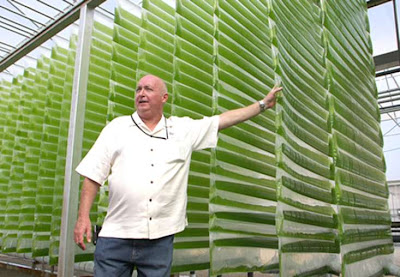How Much Oil
from
Algae?
from
Algae?
I recently got myself all excited about Valcent’s “Vertigro” algae system and other algae start-ups. I was doing a bit of research, regarding oil yield for different crops, when I came upon Keith Addison’s excellent site: JourneyToForever http://journeytoforever.org
I noticed that Keith did not have much by way of reference to algae and its oil yield on his site which was otherwise extensive in its information, so I wrote to him. Keith's rapid reply somewhat burst the bubble of my enthusiasm about algae, and brought in a firm and balancing realism to my thinking. I want to share this with you so here is our correspondence:
Hi Keith - I found your site on a Google search for oil crop yields.
It is great so see such an amount of information and interest packed
into your pages. I could find little on algae as a source of lipids.
One of the most exciting areas I have been exploring is in algae oil
production. The latest figures suggest yields as high as 100,000 gal
per acre per year for vertical closed systems. That is just amazing
given that this crop can be grown just about anywhere.
Cheers, Tony
Keith's reply:
Hello Tony
Thank you, but there is no such thing as oil from algae or biodiesel
from algae outside of a few lab experiments, nor is there likely to
be any time soon, and if there is it will be industrial-scale stuff,
not Appropriate Technology.
http://www.mail-archive.com/biofuel@sustainablelists.org/msg70264.html
[Biofuel] Algal Biodiesel: Fact or Fiction? - John Benemann
Sat, 16 Jun 2007
A thorough analysis:
http://biopact.com/2007/01/in-depth-look-at-biofuels-from-algae.html
An in-depth look at biofuels from algae
http://biopact.com/2007/07/scientist-skeptical-of-algae-to.html
Scientist skeptical of algae-to-biofuels potential - interview
Best wishes
Keith Addison
Journey to Forever
KYOTO Pref., Japan
http://journeytoforever.org/
With my bubbble somewhat burst I replied:
Thanks for that Keith,
You have me thinking in a different plane now - I guess I was taking
too much of the news and hype on algae farming as gospel. Your input
has started me of with a bit of balance reading.
Cheers,
Tony
Keith's comforting words:
Hi Tony
Sorry to be such a wet blanket!
I think a lot of the problem is that people want a replacement for
petroleum use, and there isn't one. You might find this interesting:
"How much fuel can we grow? How much land will it take?"
http://journeytoforever.org/biofuel.html#howmuch
Appropriate Technology biofuels are fine, small-scale, local projects
making biodiesel and ethanol for local use, mostly from wastes. But
the bigger they get the less appropriate they become. And there is
indeed a LOT of hype (not only about algae).
All best
Keith
I would not be rushing out to invest in Algal Oil just yet. I would like to see some real return figures first.
.










